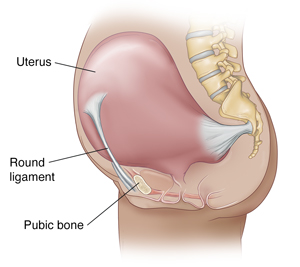Round ligament pain is a common problem in pregnancy. Ligaments are strong tissues that connect bones, muscles, and organs. There are two round ligaments. There is one on each side of the uterus. The top part of each ligament attaches to the upper side of the uterus. The bottom of each ligament attaches down in the pubic area. These ligaments help keep the uterus in place as you move around.
What causes round ligament pain in pregnancy?
As your uterus grows during pregnancy, the round ligaments are stretched and work harder when you move around. They may stretch too quickly when you stand up or bend or laugh. Nearby nerves may be irritated, or the ligaments may have a painful spasm.
Symptoms of ligament pain in pregnancy
The symptoms are sharp pains that last a few seconds. The pain may happen most often on the right side of the belly. It may happen in the hip, the lower belly, or even deep down in your pubic area. The pain may happen when you:
-
Move suddenly
-
Stand up
-
Walk
-
Roll over in bed
-
Laugh
-
Cough
-
Sneeze
Diagnosing round ligament pain in pregnancy
Your healthcare provider will ask about your symptoms and give you a physical exam. They may give you tests to check for other problems that can cause pain, such as an ovarian cyst or enlarged vein (varicocele). They will also check for signs of preterm labor or other pregnancy problems.
Treatment for round ligament pain in pregnancy
To help prevent pain:
-
Move slowly when you stand up, roll over, turn, or bend.
-
Don’t stand for long periods of time.
-
Don’t lift heavy objects.
-
Do gentle daily stretches of your hip joints.
When to call your healthcare provider
Call your healthcare provider right away if you have any of these:
-
Fever of 100.4°F (38°C) or higher
-
Pains that last more than a few minutes
-
Pain that gets worse
-
Bleeding, nausea, vomiting, or other new symptoms


